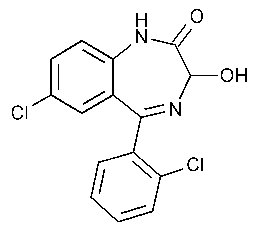Lorazepam
2H-1,4-Benzodiazepin-2-one,7-chloro-5-(2-chlorophenyl)-1,3-dihydro-3-hydroxy-,(±)-.
(±)-7-Chloro-5-(o-chlorophenyl)-1,3-dihydro-3-hydroxy-2H-1,4-benzodiazepin-2-one [846-49-1].
»Lorazepam contains not less than 98.0percent and not more than 102.0percent of C15H10Cl2N2O2,calculated on the dried basis.
Packaging and storage—
Preserve in tight,light-resistant containers.
USP Reference standards á11ñ—
USP Lorazepam RS.USP Lorazepam Related Compound A RS.USP Lorazepam Related Compound B RS.
Identification—
A:
Infrared Absorption á197Kñ.
B:
The RFvalue of the principal spot observed in the chromatogram of the Test preparationobtained as directed in Related compoundstest Acorresponds to that obtained from the Identification preparation.
Loss on drying á731ñ—
Dry it in vacuum at 105 for 3hours:it loses not more than 0.5%of its weight.
for 3hours:it loses not more than 0.5%of its weight.
Residue on ignition á281ñ:
not more than 0.3%.
Heavy metals,Method IIá231ñ:
not more than 0.002%.
Related compounds—
A:
Dissolve Lorazepam in chloroform to obtain a Test preparationcontaining 2mg per mL.Dissolve USP Lorazepam RSin chloroform to obtain an Identification preparationhaving a known concentration of 2mg per mL.Dissolve USP Lorazepam Related Compound A RS(7-chloro-5-(o-chlorophenyl)-1,3-dihydro-3-acetoxy-2H-1,4-benzodiazepin-2-one)in chloroform to obtain a Standard preparationhaving a known concentration of 20µg per mL.Dilute portions of this Standard preparationquantitatively with chloroform to obtain solutions having concentrations of 10µg per mL(Diluted standard preparation A)and 4µg per mL(Diluted standard preparation B),respectively.Within 30minutes after preparation,apply separately 50µLof the Test preparation,the Identification preparation,the Standard preparation,the Diluted standard preparation A,and the Diluted standard preparation Bto a suitable thin-layer chromatographic plate (see Chromatography á621ñ)coated with a 0.25-mm layer of chromatographic silica gel mixture and previously washed with a mixture of chloroform,ethyl acetate,and methanol (2:1:1)and dried in air.Allow the spots to dry,and develop the chromatograms in a solvent system consisting of a mixture of chloroform,dioxane,and glacial acetic acid (91:5:4)until the solvent front has moved to within 2cm to 3cm from the top of the plate.Remove the plate from the developing chamber,mark the solvent front,and allow to air-dry for about 30minutes.Examine the plate under short-wavelength UVlight.Compare the intensities of any secondary spots observed in the chromatogram of the Test preparationwith those of the principal spots in the chromatograms of the Standard preparationand the Diluted standard preparations:the sum of the intensities of all secondary spots obtained from the Test preparationcorresponds to not more than 1.0%.
B:
Transfer 50.0mg of Lorazepam to a 10-mLconical flask,add 2.5mLof acetone,and shake.Allow any undissolved particles to settle,and use the supernatant as the Test preparation.Dissolve USP Lorazepam Related Compound B RSin acetone to obtain a Standard preparationhaving a known concentration of 10µg per mL.Apply separately 50µLof the Test preparationand 10µLof the Standard preparationto a suitable thin-layer chromatographic plate (see test Aunder Related compounds).Allow the spots to dry,and develop the chromatograms in a solvent system consisting of a mixture of chloroform,dioxane,and glacial acetic acid (91:5:4)until the solvent front has moved not less than 10cm from the origin.Remove the plate from the developing chamber,mark the solvent front,and allow the solvent to evaporate.Lightly spray the plate with 2Nsulfuric acid,dry at 105 for 15minutes,and spray successively with sodium nitrite solution (1in 1000),ammonium sulfamate solution (1in 200),and N-(1-naphthyl)ethylenediamine dihydrochloride solution (1in 1000),drying the plate with a current of air after each spraying.Observe the plate under visible light:the spot produced by the Test preparationis not greater in size or intensity than the principal spot produced at the corresponding RFvalue by the Standard preparation,corresponding to not more than 0.01%of 2-amino-2¢,5-dichlorobenzophenone (lorazepam related compound B).
for 15minutes,and spray successively with sodium nitrite solution (1in 1000),ammonium sulfamate solution (1in 200),and N-(1-naphthyl)ethylenediamine dihydrochloride solution (1in 1000),drying the plate with a current of air after each spraying.Observe the plate under visible light:the spot produced by the Test preparationis not greater in size or intensity than the principal spot produced at the corresponding RFvalue by the Standard preparation,corresponding to not more than 0.01%of 2-amino-2¢,5-dichlorobenzophenone (lorazepam related compound B).
Assay—
Dissolve about 400mg of Lorazepam,accurately weighed,in 50mLof N,N-dimethylformamide.Titrate the solution with 0.1Ntetrabutylammonium hydroxide VS,taking precautions against the absorption of atmospheric carbon dioxide,determining the endpoint potentiometrically,using a glass electrode and a calomel electrode containing a saturated solution of potassium chloride in methanol (see Titrimetry á541ñ).Perform a blank determination,and make any necessary correction.Each mLof 0.1Ntetrabutylammonium hydroxide is equivalent to 32.12mg of C15H10Cl2N2O2.
Auxiliary Information—
Staff Liaison:Ravi Ravichandran,Ph.D.,Senior Scientist
Expert Committee:(PA3)Pharmaceutical Analysis 3
USP28–NF23Page 1152
Pharmacopeial Forum:Volume No.29(6)Page 1918
Phone Number:1-301-816-8330
